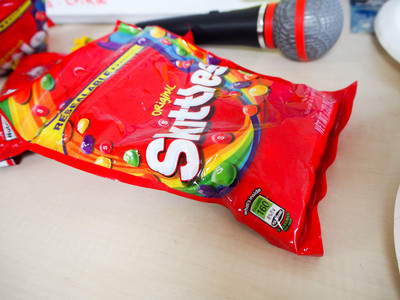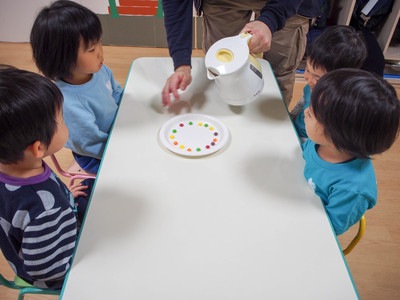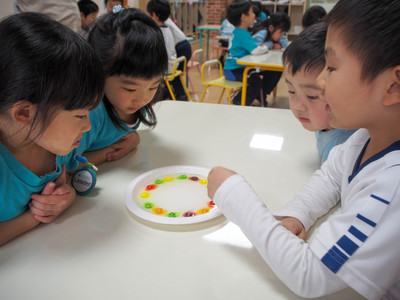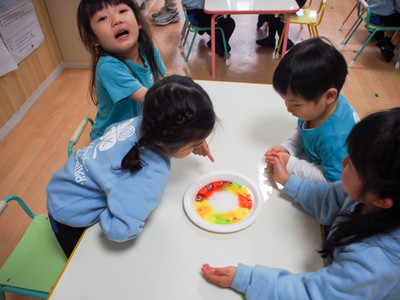Skittles Rainbow - Job Training: Scientist -
Preschool
2018.03.10
Last week for our scientist training we did an experiment with skittles. At first we talked about the different senses, including touch, hearing, sound, and sight! We excluded taste because we weren’t going to feed them the popular American candy (too much sugar!). Everyone in the USA knows about these candies, so aside from being a scientific experiment it also served as a bit of a multicultural activity!

For sight I had them examine and talk about the shape, size, color, and told them that something was written on them (each one has an “s” printed on it). For the sound, they tapped them on the table to see what kind of sound they would make. For touch, they discussed whether they were hard, soft, fluffy, or another adjective, and then asked if they were a little hard or very hard. They smelled it and some said that it smelled good, comparing it to fruit (which is probably a good answer considering they are fruit flavored candies!)


Then we got to the fun part. I explained to all of them that there was food coloring on the skittles that made them different colors. Many of the children remembered food coloring from an experiment that was done last year involving putting the food coloring into water and seeing what colors they could get. To my surprise, many of them already knew that you get green from mixing yellow and blue, purple from mixing blue and red, and orange from mixing red and yellow!
The children placed the skittles in a circle along the outside of the plate. Then, we took some warm water and poured it into the center until it reached the skittles. The children were delighted to see that when the coloring came off, they didn’t mix very much and they created a sort of rainbow! Slowly the colors floated towards the center. Then, after they mixed the water up, each group got one color to add more of that color. For example, one group added additional red skittles, another group additional yellow. There were five colors and five groups, so it worked out perfectly! Once the colors had become more pronounced, they walked around to each others’ groups and looked at the differences between the water color!



At this age they really like to see colors mixing and like to set up experiments for themselves, so this was perfect for their age group. I was just delighted that none of the students tried to sneak some candy into their mouths! We’ll continue more great science experiments throughout March.

For sight I had them examine and talk about the shape, size, color, and told them that something was written on them (each one has an “s” printed on it). For the sound, they tapped them on the table to see what kind of sound they would make. For touch, they discussed whether they were hard, soft, fluffy, or another adjective, and then asked if they were a little hard or very hard. They smelled it and some said that it smelled good, comparing it to fruit (which is probably a good answer considering they are fruit flavored candies!)


Then we got to the fun part. I explained to all of them that there was food coloring on the skittles that made them different colors. Many of the children remembered food coloring from an experiment that was done last year involving putting the food coloring into water and seeing what colors they could get. To my surprise, many of them already knew that you get green from mixing yellow and blue, purple from mixing blue and red, and orange from mixing red and yellow!
The children placed the skittles in a circle along the outside of the plate. Then, we took some warm water and poured it into the center until it reached the skittles. The children were delighted to see that when the coloring came off, they didn’t mix very much and they created a sort of rainbow! Slowly the colors floated towards the center. Then, after they mixed the water up, each group got one color to add more of that color. For example, one group added additional red skittles, another group additional yellow. There were five colors and five groups, so it worked out perfectly! Once the colors had become more pronounced, they walked around to each others’ groups and looked at the differences between the water color!



At this age they really like to see colors mixing and like to set up experiments for themselves, so this was perfect for their age group. I was just delighted that none of the students tried to sneak some candy into their mouths! We’ll continue more great science experiments throughout March.
Kevin



















